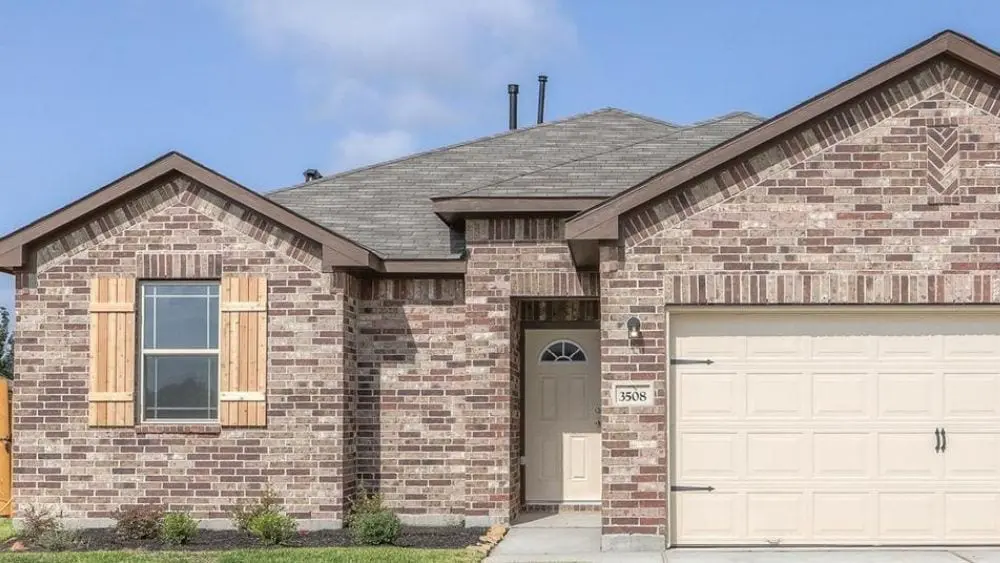
Bricks are all natural, composed of some of the earth’s most abundant elements: Clay and shale. They are environmentally friendly and 100 percent recyclable, often returned to the clay mixture or even reused for landscaping material.
Brick has a rich heritage in the U.S. that dates back to the colonial days in New England. When the first kiln was manufactured in 1629, brick became the preferred material for the home’s exterior. Its durability is evidenced by an array of centuries-old brick homes still standing today.
Since some exterior siding is nearly impossible to change post-installation, it’s important to consider how it will fit your home’s style and your personal budget.
Let’s review more about the benefits, versatility, costs, and energy efficiency of brick siding.
What’s the Difference Between Solid Brick & Brick Veneer?
Solid brick masonry was first used in the ancient world while brick veneer is the new kid on the block, arriving around 1960. It quickly became a popular alternative because of its affordability and accessibility of construction by eliminating extra labor steps.
Brick veneer is often described as a siding, because it does not possess the load-bearing properties of true brick. The construction of a solid brick home–also referred to as double brick homes–have two parallel layers of bricks. In some cases, there may be one layer of concrete block that has an adjacent layer of brick on the home’s exterior.
Double brick homes are known for their strength and ability to support enormous weight. As load bearing walls, they are a vital part of the home’s structure. In fact, if the bricks were removed, the integrity of the home would be weakened significantly.
Contrarily, when brick veneer is installed, it merely adds curb appeal; it provides no structural support to the home as bricks are only added against the exterior wall.

How Much Does Brick Siding Cost?
When counting the cost, brick veneer wins. Solid masonry brick comes with a price tag of $6 to $15 per square foot. Of course, this also includes the added benefit of impressive durability and structure. If you want the appearance of time-honored brick at a less expensive price point, veneer is priced at $4 to $10 per square foot.
The Benefits of Advantages of Brick
Maintenance Free
Most exterior sidings require occasional maintenance and even replacement. This is not the case with brick; it will last a lifetime – and then some. The color never fades and it does not require a fresh coat of paint; but if you want to freshen up the exterior, paint is an easy fix.
Noise Reduction
If you are on a quest to block out external noise, brick may be your best option – especially for those who work by night and sleep by day. Brick is inherently dense, and when sound waves hit the wall, they are mostly deflected.
Infinite Color Choices, Design Styles, and Sizes
Bricks come in an infinite array of colors; each batch that comes out may not look exactly like the one before or after it. Decades ago, homeowners tended to stick with classic red brick, but the preference today is for gray, tan, and yellow-brown. Also, different sized bricks can be assembled on a home’s exterior in various orientation patterns to create a distinctive dimension.
Durability and Fire Resistance
When tested by fire, no other exterior siding can outperform brick. Any material that can withstand being fired in a kiln at nearly 2,000 degrees Fahrenheit is placed in a non-combustible class of its own. Consequently, homeowner insurance premiums are typically lower on brick homes.
Brick also adds an extra layer of protection during severe windstorm events, protecting from debris and other hazards.
Energy Efficient
For modern homeowners, energy efficiency is key. Brick acts as a temperature stabilizer; on hot summer days there’s minimal heat absorption, and in the winter, brick keeps in the warmth. Homeowners in hot climates with brick exteriors tend to have lower energy bills.
Appreciation in Home Value
Brick can also increase property value due to its longevity and durability. Whenever you reach a decision to sell your home, you can expect an approximate six percent increase in its value because of your home’s brick siding.

Why is Brick Veneer Siding Popular?
In one word: Insulation. Although veneer brick itself has no insulation properties, it can fill gaps and voids, which can increase your R-value – or insulation rating. When the R-value is high, the insultation stops heat transfer inside and outside of the home, resulting in greater thermal protection.
On the other hand, two rows of solid brick masonry may have a lower insulation value, as many air gaps or voids exist between studs. There are additional steps contractors can take to improve the insulation; just know that these may come at an added cost.
Brick can give your home personality and give you peace of mind, as it requires no maintenance. No matter what style home or what roofing materials you select, brick will give you a great return on your investment.


Tiffany Tillema
Veneer is just non-structural. A Full-thickness brick applied with an air gap is still veneer. Almost no one these days uses brick in a structural way. Also Thin brick is more expensive than full thickness as they are processed differently.